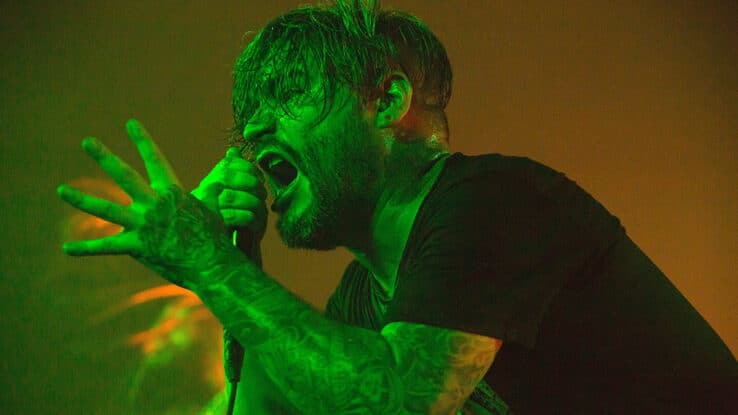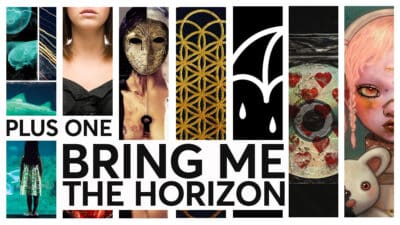Music

WTF is...
WTF is… deathcore?
Know your Suffocation from your Winds Of Plague? Here’s your handy 101 on the gnarliest sub-genre around
Revered. Reviled. Never ignored.
Deathcore is one of those genres that has always received a passionate response from whoever you talk to about it. To some, it’s the pinnacle of brutality. The nastiest parts of extreme music brimming with brain-melting grit and gut-punching depth. To others, it’s a title they wish to avoid, an experiment gone wrong that should’ve been left in the underground and not allowed to see the light of day. Though despite the different opinions, such heated conversation is everything that alternative music should be about. A style of music that is so polarising that it will never go away and, in recent years, deathcore has experienced its biggest-ever boom.
But when did the genre cut its teeth? Why is it such a hot topic whenever it rears its ugly head? Where has it found its successes, and where is it heading in the future? What even is deathcore, if you can really define it? Let’s take a look.
The early days of deathcore
In its simplest terms, deathcore can best be described as a base layer of hardcore and metalcore with a death metal influence. Breakdowns, two-steps and harsh vocals, but with technical riffs, harsh atmospheres and blood-thirsty intent.
Though not officially known as a genre back in the 90s, you can hear the start of something brewing via a few bands. There’s inspiration in the classic album, The Rain In Endless Fall, by Prayer For Cleansing, and lashings of harsh disdain on Embodyment’s Embrace The Eternal, released in 1999 and 1998 respectively. On the other side of the coin, you also had Dying Fetus and Suffocation – death metal stalwarts who were incorporating those breakdowns and mosh parts into their compositions. All the pieces were in place, but it certainly wasn’t a movement in its own right yet.
It was in the mid 00s that more of a clear-cut distinction could be made. Despised Icon reared their head from the depths of Montreal, delivering a belligerent version of hardcore with guttural vocals and technical riffing aplenty. Then came The Red Chord, who brought unrelenting hatred to the picture, and All Shall Perish, who incorporated squirm-inducing lyrical turns into their battering ram barrage.
The true breakout moment for the genre though came thanks to Myspace and, more specifically, Job For A Cowboy. With their debut EP, Doom, released in 2005, the band showcased an unrelenting sound, with tribal energy to keep the mosh pit spinning and enough mechanical grit to incite the old-school headbangers. Gaining traction, they were signed by Metal Blade Records, cementing a broader interest in the genre from an industry searching for the next big thing. On the other side of the Atlantic, a little band called Bring Me The Horizon brought deathcore to the UK, taking more influence from Gothenburg melo-death titans such as At The Gates. Their debut album, 2006’s Count Your Blessings was the result, which feels just as scrappy, violent and devastating today. And it was here that interest in the genre really started to pick up speed.
Deathcore’s commercial boom and bust
Once the floodgates were open, there was no stopping the rise of deathcore. Suddenly, a vast array of sounds could now be placed under the genre’s banner. Suicide Silence showed how vicious it could be, with 2007 debut album, The Cleansing, delivering such face-pulverising cuts as ‘Bludgeoned To Death’ and ‘No Pity For A Coward’. Their follow-up, 2009’s ‘No Time To Bleed’, would even hit the Top 40 on the Billboard 200, an actual moment of validation for a scene that had lived in the shadows for so long.
Joining them during this period of prosperity would be Whitechapel. Sitting more on the death metal side of things, their 2008 album, This Is Exile – a chainsaw circus of devilish proportions – would also have its moment on America’s biggest chart. Then there was As Blood Runs Black, showing how taking the most razor-sharp aspects of death metal and moulding them with the chaotic pace of metalcore could create something outrageously fun with their debut album, Allegiance. Chelsea Grin, Carnifex and Winds Of Plague would also find their place in the mix, showcasing their own brands of deathcore that spanned from the disgustingly abrasive to the belligerently powerful.
As time went on, the core ambitions of bands changed as well, with more focus being placed on different areas of their sound. Oceano, with their powerhouse vocalist Aaron Adam Warren – capable of conjuring sounds that mimicked planets bursting into flames – focused their attention on the more bludgeoning end of the scale. Aversion Crown made theming their focus, putting stories of aliens invading Earth at the forefront of their assault. And Thy Art Is Murder turned their attention from blood-splattering horror to calling out social injustice without ever losing any of their skull-smashing heft.
Though it’s around this period that perceptions started to shift. An association with deathcore was seen as an insult to some – an attempt to place them under a moniker that they didn’t ask for. More and more of the forefathers of the genre either called it a day or started to opt for a more contemporary sound with their later releases. Though there were still groups flying the flag and keeping the faith through the mid 2010’s, the scene’s momentum wasn’t quite what it had been. Something needed to change.
Deathcore’s modern resurgence
Considering that the genre first found its place via word of mouth, and in small and sweaty venues worldwide, it would take more a lot more virality to wake the sleeping giant at the start of the 2020s.
That came in the form of Lorna Shore, as they introduced their new singer, Will Ramos, in 2021 with ‘To The Hellfire’. Though the band had been cutting their teeth for almost a decade at this point, the circumstances surrounding this particular release worked in their favour. In a world locked down, and with more people looking at their screens than ever before, Lorna Shore were able to conduct some serious electricity. And in many ways, the track served as the ultimate example of what deathcore should be. Atmospherically devilish, technically bold and unashamed with just how heavy it wants to go – even featuring a guttural refrain that is more monster than human – it triggered something of a comeback for the whole genre. It also kickstarted a worldwide love affair with the band, allowing them to appear at Lollapalooza and letting their 2022 album, Pain Remains, become an instant classic.
The recent batch of bands pushing for supremacy sounds very different to those who plied their trade at the beginning of the genre’s journey. Though more melodic and sprawling in part, they also allow the heavier elements to sound even more despondent and dark. Take Signs Of The Swarm with their otherworldly and ambitious compositions, or Mental Cruelty, who even pulled in splatters of black metal to intensify their storytelling tenfold. Rotterdam’s DISTANT focus on producing downbeat masterstrokes that leave you feeling like you’re coated in tar, whilst Brand Of Sacrifice work with high concepts, taking inspiration from the classic anime Berserk to heighten their space-age wickedness.
Music has become more readily available thanks to streaming and social media, letting reaction video makers showcase the most brutal moments they can find. A whole new audience has become readily available and hungry to dive into the abyss. Whereas deathcore was kept separate from the rest of the metal landscape in the past, now the streams have crossed – and the opportunity to infiltrate heavy music as a whole is more prominent than ever.
The future of deathcore
Much like everything in this life, things come in cycles. So, with the melodic sensibility of the genre reaching its peak, bands are now looking back to the very beginning of what it was that made deathcore such an underground hit in the first place. Psycho-Frame are the frontrunners in this race, incorporating the savage speed of Suicide Silence with the disgustingly brash force of The Red Chord. Then there’s Bodysnatcher, who are bringing hardcore back into the mix, writing songs about life’s hardships and mirroring the heaviness of these themes in their backing track. Then you also have To The Grave, showing off the best of Australian mayhem. With a message of tolerance and understanding at its core, especially regarding animal welfare, they possess all of the downbeat decadence and guttural grandiose to go right to the top.
This acknowledgement of the past and the desire to return to some of the chaos that forged the genre’s name in the first place feels like a natural place for deathcore to grow. It’s a chance for those not there the first time around to let loose like it’s 2008 all over again. With so much now happening at once, deathcore is having the brightest and most exciting moment it has had in its 25-year story.
Photo credit: Joey Foley/Getty Images









